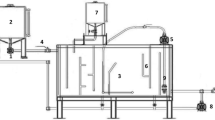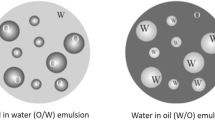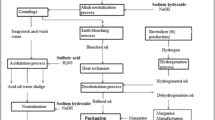Abstract
Fuel and lubricating oil leaks produce an oily wastewater that creates an environmental problem for industries. Dissolved air flotation (DAF) has been successfully employed for the separation of oily contaminants. Collectors constitute an auxiliary tool in the DAF process that enhances the separation efficiency by facilitating the adhesion of the contaminant particles. The use of biosurfactants as collectors is a promising technology in flotation processes, as these biomolecules are biodegradable and non-toxic. In the present study, a biosurfactant was produced from the bacteria Pseudomonas aeruginosa UCP 0992 cultivated in 0.5% corn steep liquor and 4.0% vegetable oil residue in a bioreactor at 225 rpm for 120 h, resulting in a surface tension of 26.5 mN/m and a yield of 26 g/L. The biosurfactant demonstrated stability when exposed to different temperatures, heating times, pH values and salt and was characterised as a glycolipid with a critical micelle concentration of 600 mg/L. A central composite rotatable design was used to evaluate the effect of the crude biosurfactant added to a laboratory DAF prototype on the removal efficiency of motor oil. The isolated and formulated forms of the biosurfactant were also tested in the prototype after the optimisation of the operational conditions. The results demonstrated that all forms of the biosurfactant increased the oil separation efficiency of the DAF process by 65 to 95%. In conclusion, the use of biosurfactants is a promising alternative as an auxiliary tool in flotation processes for the treatment of oily waters generated by industrial activities.








Similar content being viewed by others
References
Abdel-Mawgoud AM, Aboulwafa MM, Hassouna NAH (2009) Characterization of rhamnolipid produced by Pseudomonas aeruginosa isolate Bs20. Appl Biochem Biotechnol 157:329–345. https://doi.org/10.1007/s12010-008-8285-1
Albuquerque CF, Luna-Finkler CL, Rufino RD et al (2012) Evaluation of biosurfactants for removal of heavy metal ions from aqueous effluent using flotation techniques. Int Rev Chem Eng 4:156–161
Almeida DG, Soares da Silva R, Luna JM et al (2016) Biosurfactants: promising molecules for petroleum biotechnology advances. Front Microbiol 7:1718. https://doi.org/10.3389/fmicb.2016.01718
Aparna A, Srinikethan G, Smitha H (2012) Production and characterization of biosurfactant produced by a novel Pseudomonas sp. 2B. Colloids Surf B 95:23–29. https://doi.org/10.1016/j.colsurfb.2012.01.043
Babaahmadi A (2010) Dissolved air flotation: numerical investigation of the contact zone on geometry, multiphase flow and needle valves. Master’s thesis, Dept. Civil and Environm. Eng., Chalmers University of Technology, Göteborg, Sweden
Bahadori A, Clark M, Boyd B (2013) Essentials of water systems design in the oil, gas, and chemical processing industries. Springer, New York
Beneventi D, Allix J, Zeno E et al (2009) Simulation of surfactant contribution to ink removal selectivity in flotation deinking lines. Sep Purif Technol 64:357–367. https://doi.org/10.1016/j.seppur.2008.10.033
Campos JM, Montenegro Stamford TL, Sarubbo LA et al (2013) Microbial biosurfactants as additives for food industries. Biotechnol Prog 29:1097–1108. https://doi.org/10.1002/btpr.1796
Charles Oluwaseun AC, Julius Kola O, Mishra P et al (2017) Characterization and optimization of a rhamnolipid from Pseudomonas aeruginosa C1501 with novel biosurfactant activities. Sustain Chem Pharm 6:26–36. https://doi.org/10.1016/j.scp.2017.07.001
Cooper DG, Goldenberg BG (1987) Surface-active agents from two Bacillus species. Appl Environ Microbiol 53:224–229
Conselho Nacional Do Meio Ambiente—CONAMA. Dispõe sobre as condições e padrões de lançamento de efluentes. Resolução n. 430. de 13 de Maio de 2011, Brasil
de Silva CFS, Rufino RD, Luna JM et al (2013) Enhancement of biosurfactant production from Pseudomonas cepacia CCT6659 through optimisation of nutritional parameters using response surface methodology. Tenside Surfactants Deterg 50:137–142. https://doi.org/10.3139/113.110241
de Silva R, Almeida DG, Rufino RD et al (2014) Applications of biosurfactants in the petroleum industry and the remediation of oil spills. Int J Mol Sci 15:12523–12542. https://doi.org/10.3390/ijms150712523
Deepika KV, Ramu Sridhar P, Bramhachari PV (2015) Characterization and antifungal properties of rhamnolipids produced by mangrove sediment bacterium Pseudomonas aeruginosa strain KVD-HM52. Biocatal Agric Biotechnol 4:608–615. https://doi.org/10.1016/j.bcab.2015.09.009
Deepika KV, Kalam S, Ramu Sridhar P et al (2016) Optimization of rhamnolipid biosurfactant production by mangrove sediment bacterium Pseudomonas aeruginosa KVD-HR42 using response surface methodology. Biocatal Agric Biotechnol 5:38–47. https://doi.org/10.1016/j.bcab.2015.11.006
Emmandi R, Sastry MIS, Patel MB (2014) Low level detection of benzene in food grade hexane by ultraviolet spectrophotometry. Food Chem 161:181–184. https://doi.org/10.1016/j.foodchem.2014.04.031
Freitas BG, Brito JGM, Brasileiro PPF et al (2016) Formulation of a commercial biosurfactant for application as a dispersant of petroleum and by-products spilled in oceans. Front Microbiol 7:1646. https://doi.org/10.3389/fmicb.2016.01646
Hazra C, Kundu D, Chaudhari A (2012) Biosurfactant Assisted bioaugmentation in bioremediation. In: Satyanarayana T, Johri BN, Prakash A (eds) Microorganisms in environmental management: microbes and environment. Springer, New York, pp 631–664
Helvac SS, Peker S, Özdemir G (2004) Effect of electrolytes on the surface behavior of rhamnolipids R1 and R2. Colloids Surf B 35:225–233. https://doi.org/10.1016/j.colsurfb.2004.01.001
Menezes CTB, Barros EC, Rufino RD et al (2011) Replacing synthetic with microbial surfactants as collectors in the treatment of aqueous effluent produced by acid mine drainage, using the dissolved air flotation technique. Appl Biochem Biotechnol 163:540–546. https://doi.org/10.1007/s12010-010-9060-7
Monteiro SA, Sassaki GL, de Souza LM et al (2007) Molecular and structural characterization of the biosurfactant produced by Pseudomonas aeruginosa DAUPE 614. Chem Phys Lipids 147:1–13. https://doi.org/10.1016/j.chemphyslip.2007.02.001
Moussa TAA, Mohamed MS, Samak N (2014) Production and characterization of di-rhamnolipid produced by Pseudomonas aeruginosa TMN. Braz J Chem Eng 31:867–880. https://doi.org/10.1590/0104-6632.20140314s00002473
Nicolò MS, Cambria MG, Impallomeni G et al (2017) Carbon source effects on the mono/dirhamnolipid ratio produced by Pseudomonas aeruginosa L05, a new human respiratory isolate. N Biotechnol 39:36–41. https://doi.org/10.1016/j.nbt.2017.05.013
Oliveira FJS, Vazquez L, de Campos NP, de Franca FP (2009) Production of rhamnolipids by a Pseudomonas alcaligenes strain. Process Biochem 44:383–389. https://doi.org/10.1016/j.procbio.2008.11.014
Peng JF, Song YH, Yuan P et al (2009) The remediation of heavy metals contaminated sediment. J Hazard Mater 161:633–640. https://doi.org/10.1016/j.jhazmat.2008.04.061
Rocha e Silva FCP, Rocha e Silva NMP, de Moura AE et al (2015) Effect of biosurfactant addition in a pilot scale dissolved air flotation system. Sep Sci Technol 50:618–625. https://doi.org/10.1080/01496395.2014.957319
Rubio J, Smith RW (2002) Overview of flotation as a wastewater treatment technique. Miner Eng 15:139–155. https://doi.org/10.1016/S0892-6875(01)00216-3
Santos DKF, Rufino RD, Luna JM et al (2016) Biosurfactants: multifunctional biomolecules of the 21st Century. Int J Mol Sci 17:401. https://doi.org/10.3390/ijms17030401
Sarubbo LA, Rocha RB Jr, Luna JM et al (2015) Some aspects of heavy metals contamination remediation and role of biosurfactants. Chem Ecol 31:707–723. https://doi.org/10.1080/02757540.2015.1095293
Silva SNRL, Farias CBB, Rufino RD et al (2010) Glycerol as substrate for the production of biosurfactant by Pseudomonas aeruginosa UCP0992. Colloids Surf B 79:174–183. https://doi.org/10.1016/j.colsurfb.2010.03.050
Silva EJ, Chaprão MJ, Silva IA et al (2018) Biosurfactant application as alternative collectors in dissolved air flotation system. Chem Eng Trans 64:547–552. https://doi.org/10.3303/CET1864092
Soares da Silva de CF R, Rufino RD, Luna JM et al (2013) Enhancement of biosurfactant production from Pseudomonas cepacia CCT6659 through optimisation of nutritional parameters using response surface methology. Tenside Surfactants Deterg 50:137–142. https://doi.org/10.3139/113.110241
Soares da Silva de CF R, Almeida DG, Meira HM et al (2017) Production and characterization of a new biosurfactant from Pseudomonas cepacia grown in low-cost fermentative medium and its application in the oil industry. Biocatal Agric Biotechnol 1:2. https://doi.org/10.1016/j.bcab.2017.09.004
Varjani SJ, Upasani VN (2017) Critical review on biosurfactant analysis, purification and characterization using rhamnolipid as a model biosurfactant. Bioresour Technol 232:389–397. https://doi.org/10.1016/j.biortech.2017.02.047
Watcharasing S, Kongkowit W, Chavedej S (2009) Motor oil removal from water by continuous froth flotation using extended surfactant: effects of air bubble parameters and surfactant concentration. Sep Pur Technol 70:179–189. https://doi.org/10.1016/j.seppur.2009.09.014
Wittgens A, Kovacic F, Müller MM et al (2017) Novel insights into biosynthesis and uptake of rhamnolipids and their precursors. Appl Microbiol Biotechnol 101:2865–2878. https://doi.org/10.1007/s00253-016-8041-3
Yu L, Han M (2013) A review of treating oily wastewater. Arab J Chem 10:S1913–S1922. https://doi.org/10.1016/j.arabjc.2013.07.020
Acknowledgements
This study was funded by the following Brazilian fostering agencies: State of Pernambuco Foundation for the Support of Science and Technology (FACEPE), the Research and Development Program of the National Agency of Electrical Energy (ANEEL), the Candeias Energy Company (Global Group), the Research Project (code PD-06961-0005/2016), the National Council for Scientific and Technological Development (CNPq) and the Coordination for the Advancement of Higher Level Education Personnel (CAPES). The authors are grateful to the laboratories of the Centre for Sciences and Technology of the Catholic University of Pernambuco (UNICAP), Brazil.
Author information
Authors and Affiliations
Corresponding author
Additional information
Publisher's Note
Springer Nature remains neutral with regard to jurisdictional claims in published maps and institutional affiliations.
Rights and permissions
About this article
Cite this article
Silva, E.J., Silva, I.A., Brasileiro, P.P.F. et al. Treatment of oily effluent using a low-cost biosurfactant in a flotation system. Biodegradation 30, 335–350 (2019). https://doi.org/10.1007/s10532-019-09881-y
Received:
Accepted:
Published:
Issue Date:
DOI: https://doi.org/10.1007/s10532-019-09881-y




